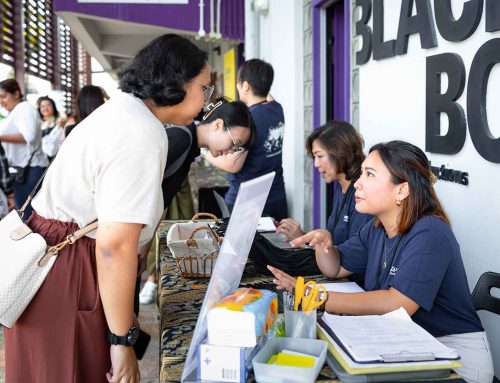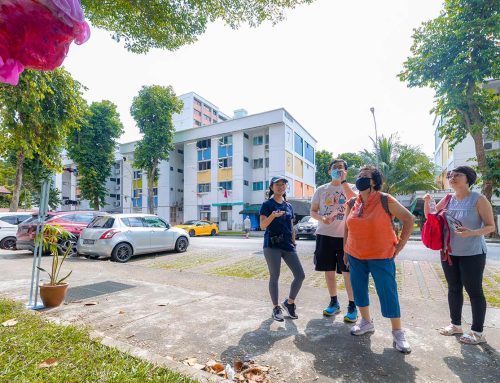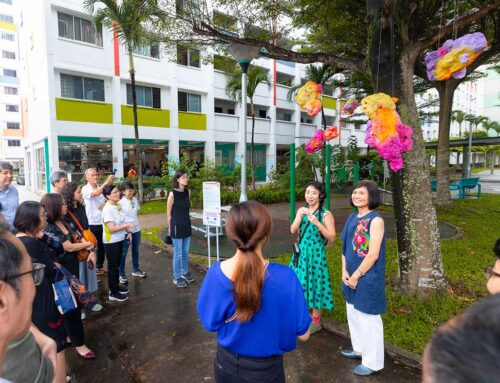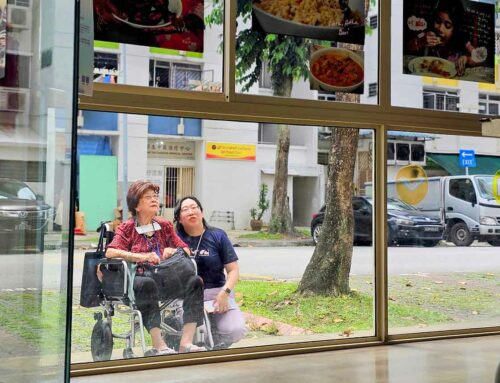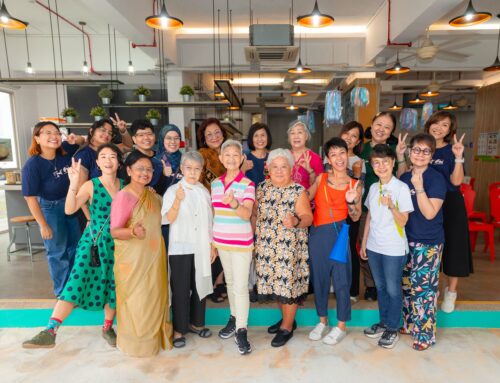Library / Project Journal
Opening the Portals
Library / Project Journal
Opening the Portals
By Salty Xi Jie Ng
31 July 2023
This post is part of a series on our Both Sides, Now project at Wellness Kampung @ 765 Nee Soon Central (2023-24). This year-long project aims to develop supportive communities for living well, and leaving well.
One Friday at lunch, I found myself gobbling seafood pasta and glutinous rice cooked by Yim Fong, a senior collaborator in our project. After our morning session, she hurried back to her home a few blocks away to heat up her dishes for us, and returned sweating and triumphant. It turned out that because she lives alone, having company for meals is something she yearns for. I was glad she had no qualms inviting us to partake in meals with her.
At the Wellness Kampung’s kitchen counter, she seemed energised as her food was enjoyed by the project team, some other seniors, centre staff, a community nurse, and regional connectors (a role to be explained later). The rice, topped with Chinese sausage and oily roasted peanuts, was perfectly matched with sambal that had been left at the centre by the community nurse who regularly stations there. We were a group of women from different backgrounds, ages, and of different roles in a fluid community, breaking bread together after a sombre discussion on life and death that some of us had engaged in shortly before. The next week, we shared lunch again.

Senior collaborator Chia Yim Fong and the second lunch she prepared. Photo by Salty Xi Jie Ng
It all began late in 2022 when the invitation came to lead this year’s Both Sides, Now project in Yishun as ArtsWok, having successfully collaborated with Drama Box for 10 years, embarked on a new phase of their flagship programme. Or should I say it all began 10 years ago with ArtsWok’s first edition of Both Sides, Now at Khoo Teck Puat Hospital? This year’s Both Sides, Now is a body of water joining the larger ocean of work that has been kneaded by many willing hearts delving into taboo subjects. We have come to join this larger sea, everyone who has found it in their destiny to be here this ripe time, with each other.
Our project is different because it will prioritise longer term engagement and be presented in a more intimate way. It is also in deeper collaboration with Yishun Health, a public healthcare institution that is quietly changing the face of health in ways that include expansive definitions of health —particularly population health— underpinned by Asset-Based Community Development (ABCD), using as one of its tools a system called Participatory Care and Support Planning (PCSP). For the purpose of setting the scene in our story, it is important to explain both these corporate-sounding acronyms, which are, at heart, about liberation. Surprising, in our island-state. And, how could we work for less?
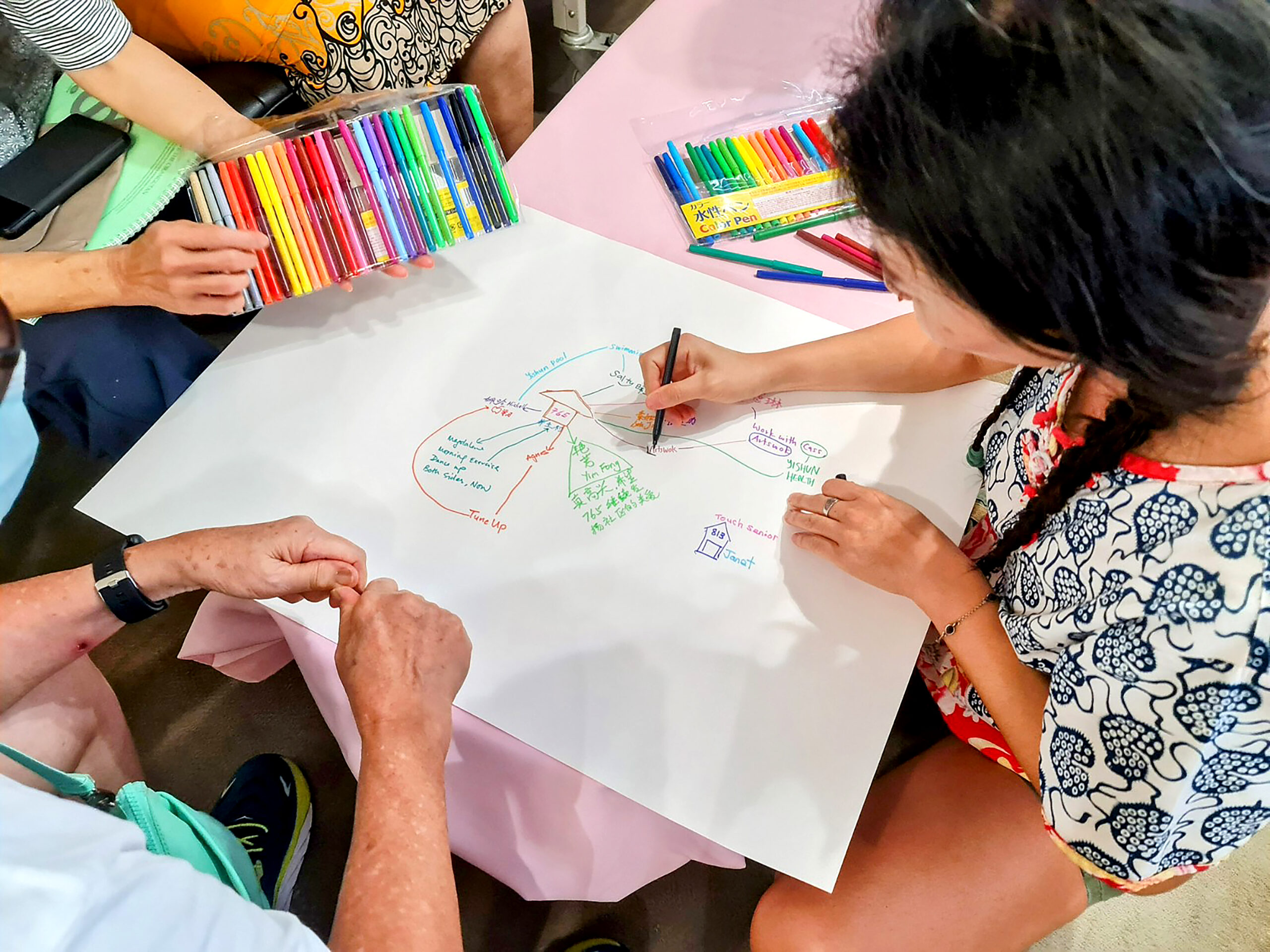
Working on a map of assets and resources. Photo by Stacy Huang
Adapted from studies of the UK health system, PCSP is essentially a set of values and skills in communication that gives people ownership of their own health — unusual in paternalistic Singapore where healthcare professionals are prescriptive and typically honoured as figures who know better. How refreshing to be an arts worker sitting in a training room with healthcare staff actively having their conceptions of power broken down with each practice conversation, and willingly so. How moving to be in the same position while Cormac Russell, a global proponent of ABCD who has been working with Yishun Health for years, answered my question about how to launch a partnership where funders approve projected outcomes, when ABCD, at its purest, is about asking communities what they care about doing and helping them lead the way.
Our project is different because it will prioritise longer term engagement and be presented in a more intimate way.
“You are funding a process, not a product,” he spoke right to my heart. Although he was speaking about asset-based community development, arts-based community development approaches are very similar; I consider them on the same spectrum as socially engaged art practices, which are about experiences, relationships, and processes — this is the art itself, not objects. The people sharing the space are the primary audience of the art that is happening. It is something the secondary and tertiary audiences cannot fully be part of — but they can experience what was shared through the project’s expressions, in forms such as images, video, installation, writing.
And even if the instigators of the project have preconceived the subject matter and envisions ways the project will unfold, there must be lots of space for how the community or the collaborators find their agency within this framework, or even change it. Only then can we honour them as subjects and experts of their singular experiences. In ABCD lingo, this is a mix of “done with” and “done by” the community. Perhaps stiff to be categorical, but helpful nonetheless in thinking about relational art-making. In employing both asset and arts-based community development approaches to nourish equitable collaborations, individual and community values can be creatively expressed.

Senior collaborator Munglam Devi and Wellness Kampung @ 765 Nee Soon Central Manager Mary Ong at the steps of the Asian Civilisations Museum. Photo by Salty Xi Jie Ng
Situating, beginning, ploughing
Our project was to be birthed at the Blk 765 Yishun St 72 Wellness Kampung — one of three vibrant neighbourhood centres, providing health screenings and mostly senior-led activities like language and craft classes, singing and dance sessions, a repair club run by a group of older men, and Share-A-Pot, a weekly meal following a set of mobility exercises. The 765 Kampung’s bubbly manager Mary soon became my ally and link to the community. I met seniors via Mary and other Yishun Health regional connectors, who manage Wellness Kampungs, run community health posts, and generally work to connect and care for people in their community in Yishun and Sembawang. Artist Stacy Huang has been assisting the creative process as she forays into working with seniors.
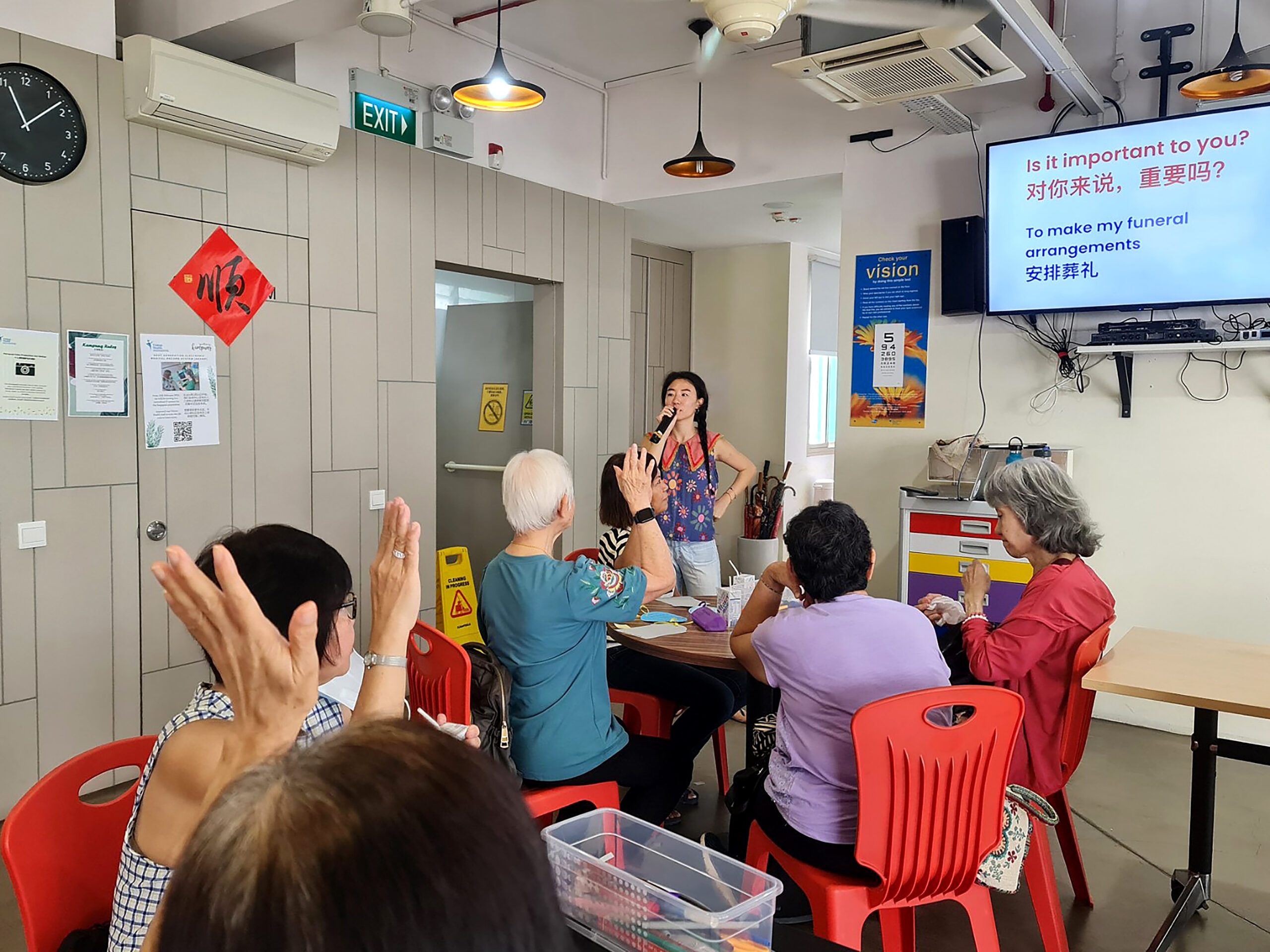
Introductory chat session at Wellness Kampung @ 765 Nee Soon Central. Photo by Stacy Huang
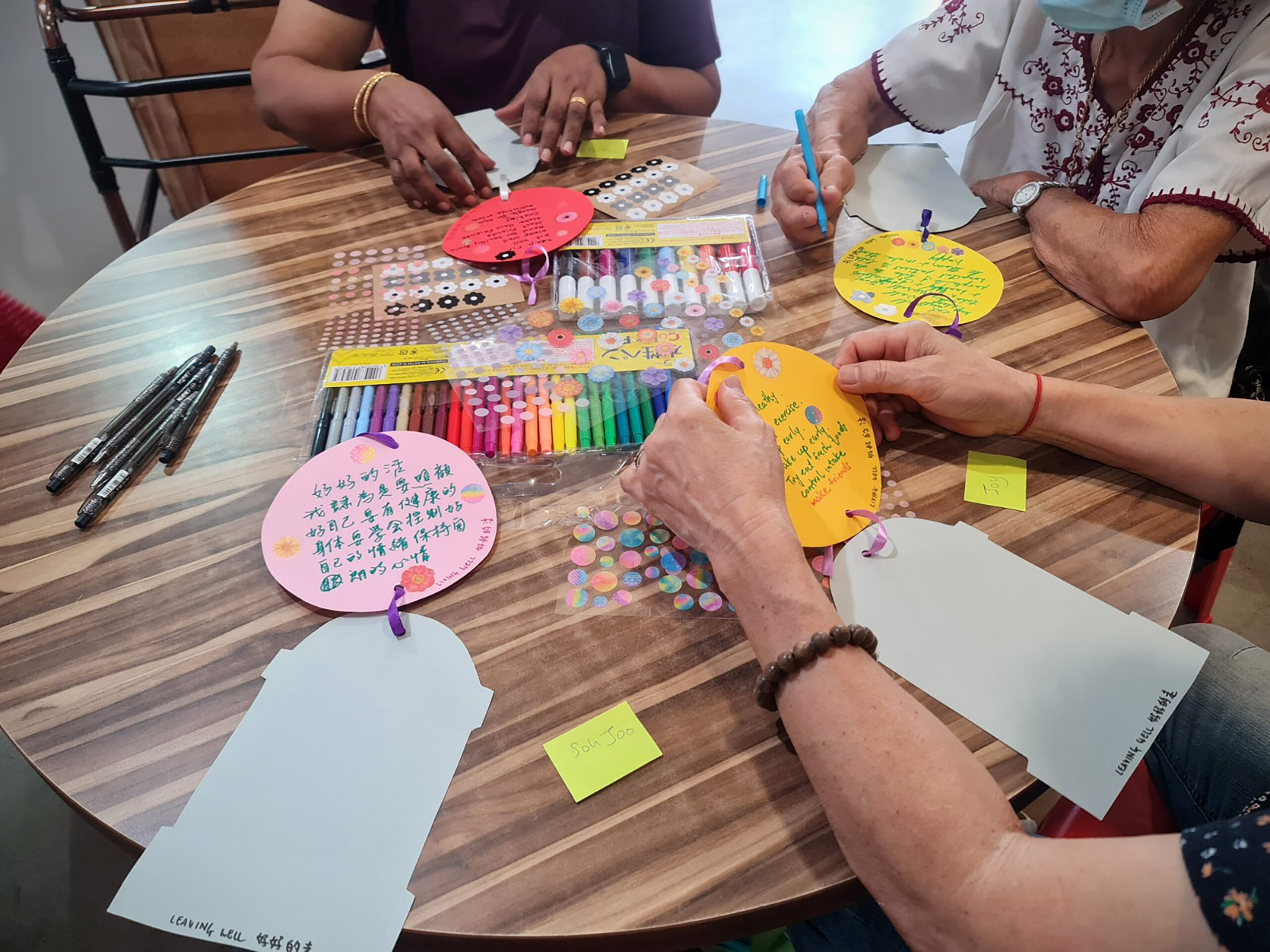
Tombstone writing/drawing activity, introductory chat session at Wellness Kampung @ 765 Nee Soon Central. Photo by Stacy Huang
I had conversations with seniors and made announcements at various activities. We then invited interested seniors to attend our bilingual chat sessions that introduced the subject matters. Seniors considered what living well and leaving well meant. They were polled on whether making their funeral arrangements were important, and wrote on their own tombstone as a way of considering how they want to be remembered. The final group was put together primarily based on their interest and schedule. Most are very active with the Wellness Kampung, participating in or leading activities — Both Sides, Now is a way for the site to offer something new and deeper to them, and for them to support others in end-of-life matters, all within the community they are part of.
Along the way, I attended Advance Care Planning (ACP) advocacy training, conducted for healthcare and administrative staff of Yishun Health. I got an overview of the process whereby people indicate their end-of-life care preferences, and began to experience how differently each person might choose what happens to them at their most vulnerable.
And so, nearly half a year after the first conversation with ArtsWok, I found myself deep in conversation about kampung memories, end-of-life priorities, and death preparations, with a group of 7-8 women I was getting to know and who were slowly letting me into their hearts. It is worth noting here that far fewer men were interested in attending our introductory chat sessions, and none of them chose to join. Introspective projects like these tend to attract more women, perhaps affirming the gender trope that women are more willing to speak and share. The team continues to hold the question of how men might want to process these issues.

Senior collaborator Agnes Tan’s map of her life as a river. Photo by Stacy Huang
In the first phase which just concluded, we met weekly to broadly explore like bees tasting a plethora of wildflowers in a summer field, in two groups split by language (English and Mandarin). In considering the meaning of a life, I invited each of them to share old photos and memories; map their current life; and draw their entire life as a meandering river, indicating roadblocks or magical elements to tell the story.
In delving into the subject of leaving well, we discussed creative outcomes from past Both Sides, Now editions; talked about possible end-of-life preparations (most in the group has done the minimal); end-of-life priorities; last meals (with sharing of artist Julie Green’s project The Last Supper – Final Meals of U.S. Death Row Inmates); funeral songs; shared a precious object to be passed down; and considered personal meanings of legacy. We meandered down many paths and into the portals of lives tenderly considered through our process of shedding light and active uncovering.
We also started a map of assets and resources in our newly defined community — difficult at first, but easier when seen from the perspective of how we are already sharing and finding resources, and leading with our skills and passions in everyday life.
Peeking into end-of-life practices and death customs across cultures was part of our education at this early stage in the process. We looked at examples like burial shrouds, and Ghana’s fantasy coffins. A field trip took us to the Asian Civilisations Museum, where curator Faisal Husni gave us a tour of the Ancestors and Rituals gallery as well as the Islamic art gallery at the Faith and Belief permanent exhibition. After tea at Killiney Kopitiam, we took a stroll at the Japanese Cemetery Park in Serangoon, as the skies darkened above. For some, it was an invigorating escape from their lives in Yishun, and added depth to our collective investigation into mortality.

Asian Civilisations Museum Curator Faisal Husni gives us a tour of the Ancestors and Rituals gallery. Photo by ArtsWok Collaborative

Stroll at Japanese Cemetery Park. Photo by ArtsWok Collaborative
In addition, I have been having one-on-one phone calls with the women for us to get to know each other better, and allow more space for processing the subject matters at hand. In understanding them, their interests and concerns more deeply, I am better able to hold space for the collective whole. The calls are steered by whatever emerges at the time and the space shared with each woman is its own nest, slowly deposited with intimate ponderings unique to each. They range from conversations about cooking and family weekends, to passing down values to one’s children and philosophical discussions about mortality and spirituality. At times, the Creative Dying card game has been a useful prompt.
The harvest so far
So much has emerged from many thoughtful, sometimes emotional, conversations individually and collectively: differing philosophical and pragmatic attitudes to preparing for death; the struggles of single seniors living alone and how they can support each other; the challenges of full-time caregiving; how to pass down intangible things like skills and values; where moments of peace are to be found amidst the struggles of ageing; and the very simple question: why do we have to die?
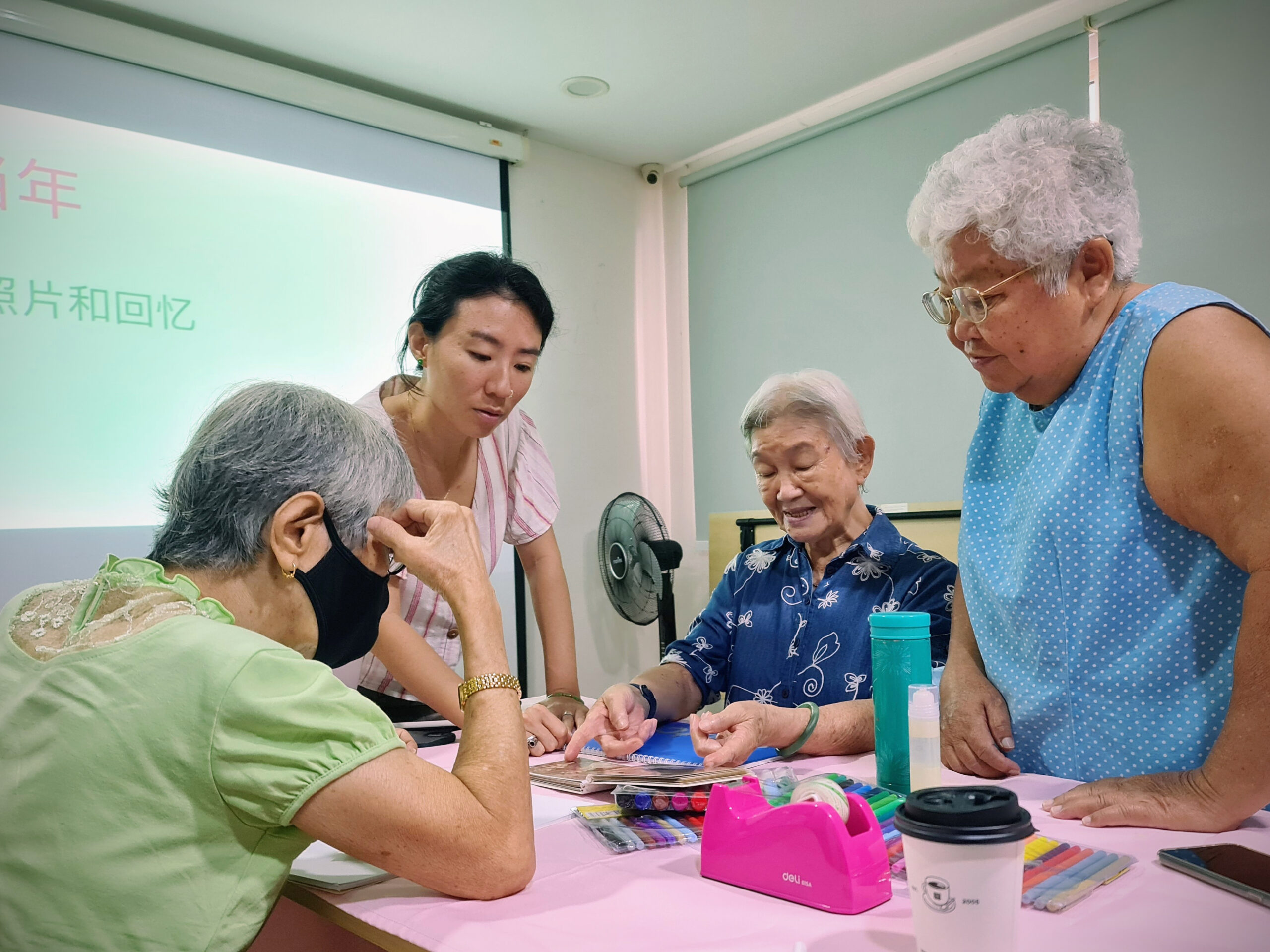
(from left) Lim Soh Joo, Salty Xi Jie Ng, Koh Tong Cheng, and Chia Yim Fong at the Mandarin group session. Photo by Stacy Huang
The amount of appreciation expressed by all has been immensely heartening. Some reflections shared at the end of the first month/phase include: having the opportunity to reflect on one’s life; having space to discuss death and end-of-life issues, and learning to address these difficult subjects; being touched by and learning from others’ stories; feeling supported by others; learning about what skills one possesses, and how to map. I honour the strength of each of these women who has arrived at this hike we are taking.
The journey that follows until March 2024 will see each of the women manifesting a creative response unique to them, having end-of-life conversations with others, an exploration into equitable communication with healthcare professionals, as well as a public sharing. This journey is supported by a web of people, from the women’s families, to the project teams at ArtsWok and Yishun Health, and others who have not appeared, but will at the right time to join this collective undertaking. At the end of the first session, one of the women reflected, “Today is a turning point in my life.” I sensed both an appreciation for the now, and a big breath for what was and is to come. With immense gratitude, I thank her and everyone in this ecology of relations for opening the portals together.
About Salty Xi Jie Ng
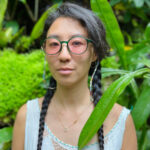
Salty Xi Jie Ng is the lead artist of Both Sides, Now 2023-24 at Wellness Kampung @ 765 Nee Soon Central. She is an artist and educator working intimately with people and their lives in relation with the other-than-human. The Grandma Reporter, her collaborative publication project about senior women’s culture across the earth, has explored style, intimacy and eroticism. She was commissioned by T:>Works Festival of Women N.O.W. to make Not Grey: Intimacy, Ageing and Being with elder Singaporean women.


